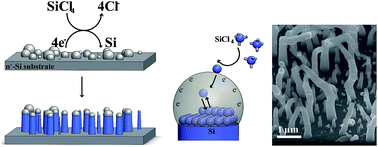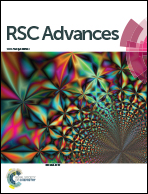Direct electrochemical deposition of crystalline silicon nanowires at T ≥ 60 °C†
Abstract
Direct synthesis of crystalline silicon (Si) nanowires at low temperatures has been achieved through an electrochemical liquid–liquid–solid (ec-LLS) process. Liquid metal nanodroplets containing Ga were used as both discrete ultramicroelectrodes and crystal growth seeds for Si nanowires. This new ec-LLS process was performed in propylene carbonate containing SiCl4 at temperatures as low as 60 °C. X-ray diffraction and Raman spectra separately and independently indicated the nanowires were crystalline as prepared. Scanning electron micrographs of Si nanowires grown on both Si(111) and Si(100) substrates further showed that the direction of nanowire growth specifically followed the crystallographic orientation of the underlying substrate, indicating deposition with homoepitaxy. Localized electron diffraction patterns collected from individual Si nanowires in a transmission electron microscope showed the characteristic pattern of the diamond cubic structure of crystalline Si. Additional experiments were performed that indicated the wetting of the electrodeposited Si by the liquid metal influenced the morphology of the resultant nanowire. These cumulative results support the overarching premise that ec-LLS is a unique synthetic method for crystalline Si nanowires at low temperatures.


 Please wait while we load your content...
Please wait while we load your content...